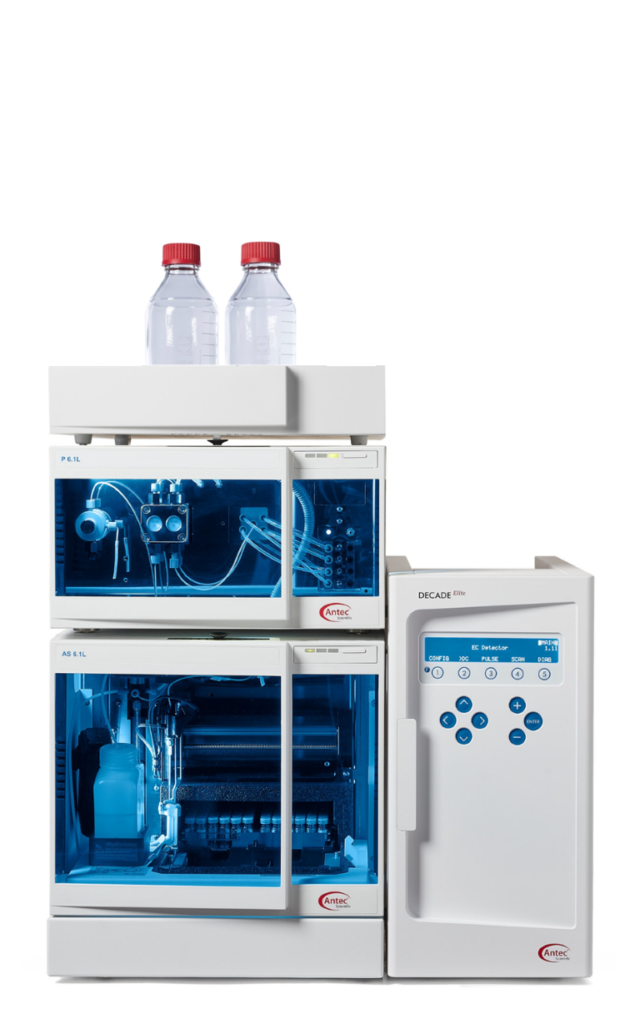Neurotransmitters
Neurotransmitter analysis
The ALEXYS Neurotransmitter Analyzer has been developed for analysis of brain tissue, fruit fly or microdialysis samples. Our application notes describe the challenges we faced and a proven track record of literature publications proves our point. The ALEXYS is based on UHPLC with electrochemical detection with a couple of unique features to make it suitable for research in neuroscience. The development process was an elimination of bottlenecks and improving the system performance to what it is now.

Small sample volume
First, the system must be suitable for handling small sample volume. This is especially important for microdialysis samples. In brain microdialysis extracellular fluid is sampled via a probe and fractions are collected for further analysis. Typical flow rates in microdialysis are 1 – 2 µL/min, decreasing the fraction size to a few microliters enables a temporal resolution of a few minutes. In the ALEXYS autosampler, injection procedures have been developed to pick up 5 out of a total of 7 µL sample volume. And by using on-line microdialysis, it is possible to analyze fractions of 2 µL directly from the sample probe by using only a sample valve. No need to first collecting it in vials and using an autosampler to inject. This makes a temporal resolution of only 1 min feasible.
Sensitivity
Second, the system must have an excellent sensitivity to be able to quantify extremely low concentrations of certain neurotransmitters. The ALEXYS uses a wall jet type flow cell with adjustable spacing, the SenCell. Detection limits down to 20 pmol/L for dopamine, serotonin and noradrenaline have been reported (0.1 fmole). For acetylcholine an intermediate step with a post column enzyme reactor is involved, and a detection limit is about 1 nmol/L can be obtained.
Separation
Third, in real life samples the detection sensitivity is not the only thing that matters, when it comes to the lowest detectable concentration. The selectivity or separation of relevant neurotransmitters from other components in the sample is evenly important. Therefore, high performance UHPLC columns have been selected for separation. Separation efficiency (plate number) of 200,000 /m have been proven feasible.
Second channel
Still, there are tough cases with co-eluting peaks, or where high and extremely low concentrations of substances elute closely together. A second channel or dual channel configuration (DCC) has been developed, with two individual HPLC method using the same sample injector with two injection loops. The same sample can be analyzed under two totally different HPLC conditions simultaneously. When analyzing the monoamine neurotransmitters including the acidic metabolites homovanillic acid (HVA), 5-hydroxyindole acetic acid (5-HIAA), and 3,4-dihydroxyphenylacetic acid (DOPAC) an excellent separation and quantification of all relevant substances is achieved under acidic (channel 1) and neutral pH conditions (channel 2).
Short analysis time
The fourth requirement – a wish in many cases – is a short analysis time or the speed of analysis. The introduction of UHPLC columns and instruments has been a game changer in that respect. Analysis time of less than 2 minutes for dopamine and serotonin in dialysis samples is now considered ‘normal’. The analysis of GABA and glutamate is using a fully automated derivatization step. By developing a method with a column wash to get rid of late eluting interferences, the total run time has been significantly reduced.
Summary
A number of methods have been developed to illustrate the versatility of the ALEXYS system. Methods for 3-hydroxykynurenine (3-HK), and fruit fly neurotransmitters octopamine, tyrosine, tryptophan and tyramine are based on the monoamine methods. Analysis of several large neutral amino acids (LNAAs – precursors for various brain neurotransmitters) has been done using the automated OPA procedure similar to GABA and glutamate. Aminothiols and glutathione play a role in brain antioxidant defense and Neurodegenerative Diseases. They are analyzed using the ALEXYS with a flow cell with a boron doped diamond electrode. Application notes are freely available for download.
Downloads
Name
Doc#
Size
Download
3─Hydroxykynurenine
213_030_04
0.45 MB
Acetylcholine and Choline
213_023_16
0.97 MB
ALEXYS Neurotransmitter Analyzer
213_027_05
1.08 MB
Aminothiols, Glutathione and disulfides
211_005_04
0.85 MB
Compilation of neuroscience applications
213_026_04
0.71 MB
Fast analysis of Dopamine and Serotonin for high time resolution
221_253_01
4.33 MB
GABA and glutamate
213_020_15
1.67 MB
Glutathione, other Thiols, and Disulfides
211_004_09
0.92 MB
Histamine
213_021_05
0.40 MB
Large Neutral Amino Acids
213_022_03
0.48 MB
Monoamines and Metabolites
213_028_11
1.18 MB
OMD of neurotransmitters
213_029_05
1.31 MB
Reductive detection of monoamines for improved selectivity
213_018_09
0.90 MB
Tyrosine, Tyramine and Octopamine
213_032_03
0.37 MB